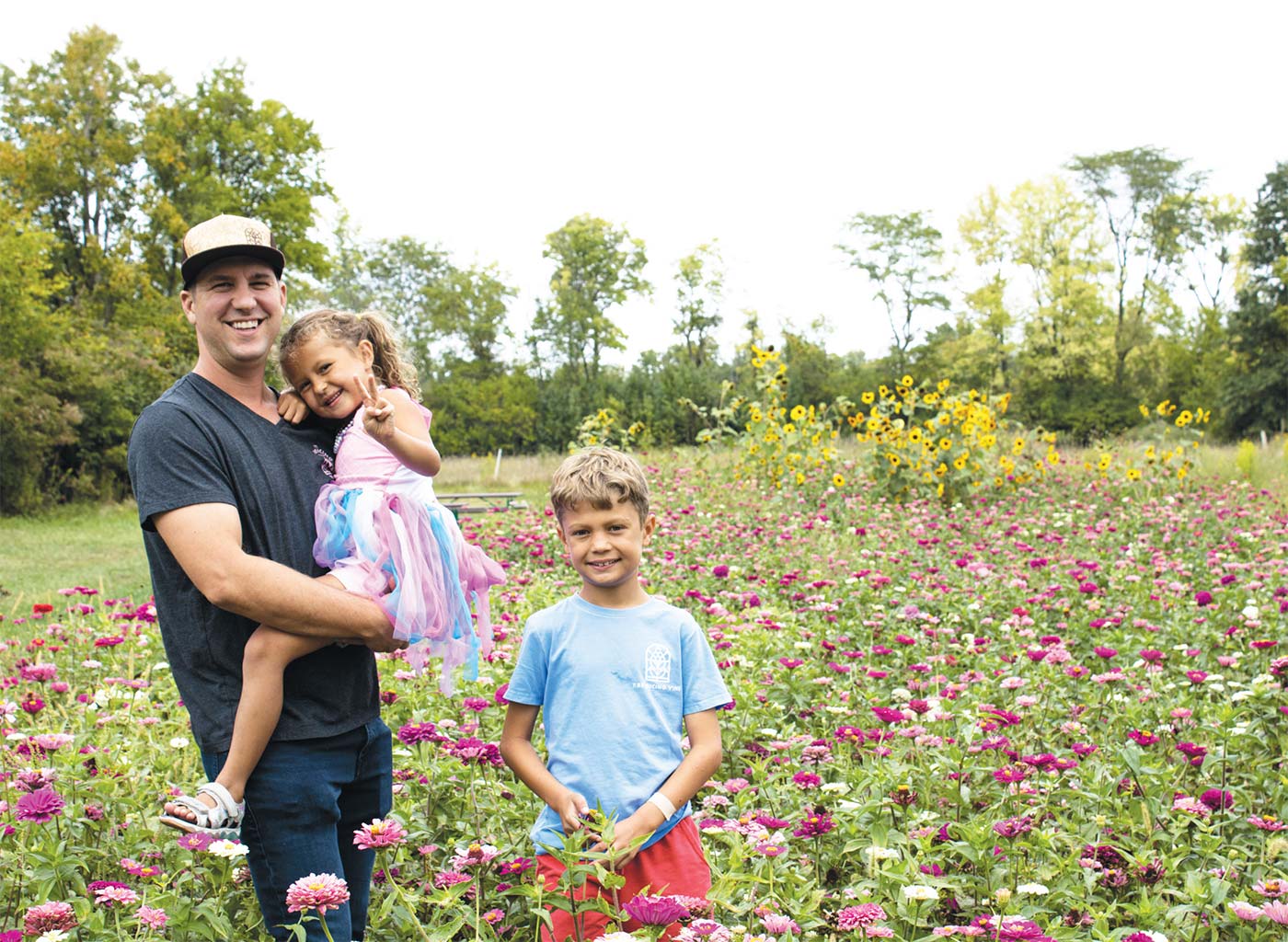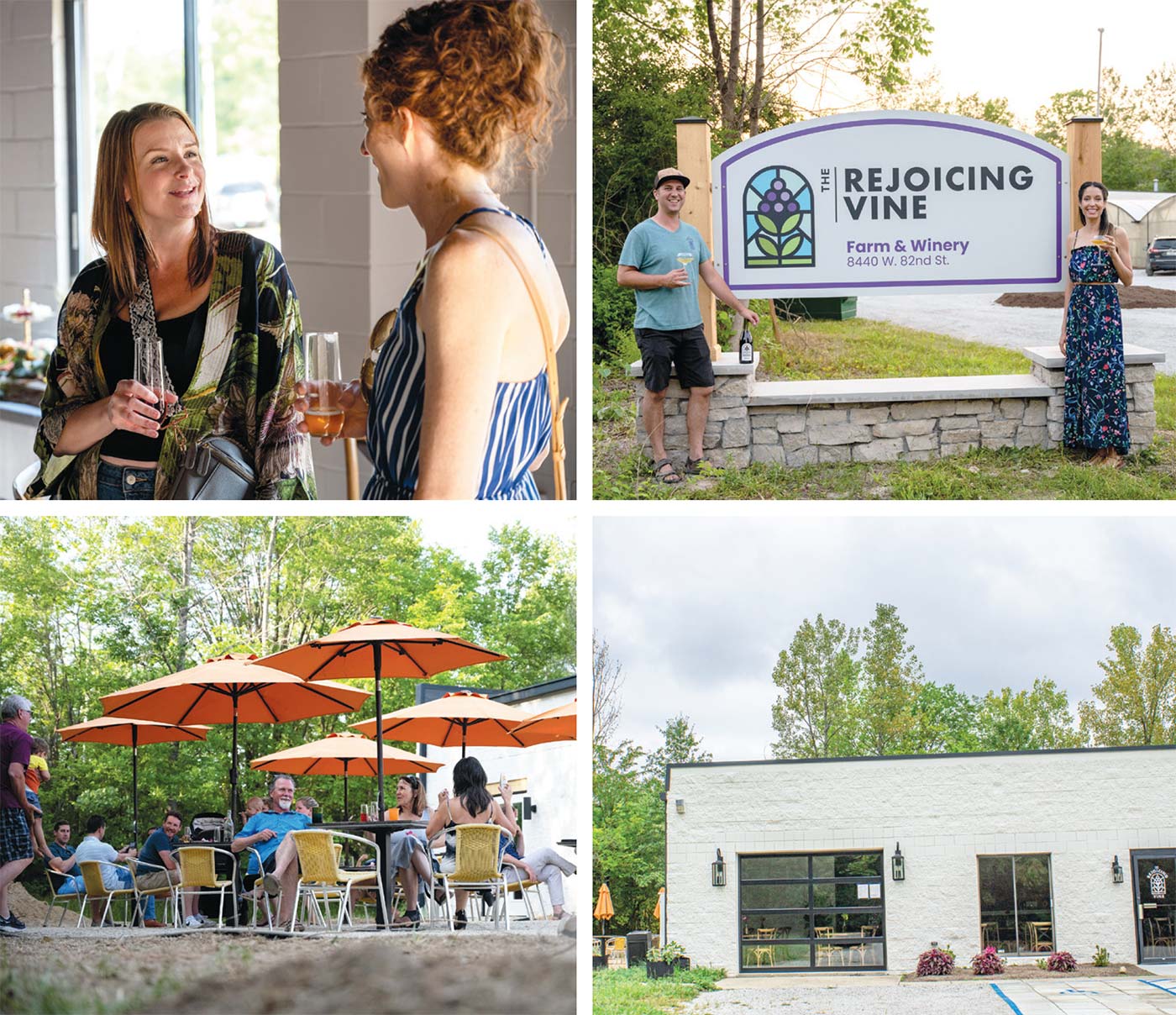Sip, Sip, Hooray!
Nestled on the north side of Indianapolis lies a quaint spot to trade the city landscape for a nature retreat. Rows of zinnias and sunflowers line the open field while grapes flourish on vines in the distance. Guests are greeted by tables topped with colorful umbrellas. If the festive scene puts you in the mood to hoist a celebratory glass of sparkling wine, you are in the right place.
Welcome to The Rejoicing Vine, a winery specializing in bubblies.
About 14 years ago, Brent and Frances Kumfer met through a mutual friend, fell in love, married and started a family. Brent was pursuing a career in engineering and working to obtain a master’s degree in innovation and entrepreneurship, and Frances was beginning a career as an emergency medicine physician. Some six years later, they realized that their two busy careers were limiting the quality time they could spend at home with each other and with their newborn son, Caleb. They made the decision that Brent would leave his engineering position to spend more time with his family. With more time at home, Brent fostered a love of gardening and growing fruit, especially grapes. One year the fostering and love turned out a particularly abundant harvest of grapes, setting a new course in motion.
“I think that’s really what sparked it all—like, ‘What are we going to do with all these grapes? We can’t possibly eat 40 pounds of grapes,’” Brent says.
“We were, like, you can make jelly, you can make wine … we would rather drink wine than eat jelly or jams,” Frances jokes.
Brent delved into learning about the winemaking process. He studied through the University of California, Davis, and sought advice from a close friend’s father, who makes wine. Frances deemed Brent a “serial learner,” stating he reads nonfiction books for fun and is always trying to learn as much as he can. Amidst his wine education, Brent became entranced with the chemistry and science behind winemaking. Specifically, he enjoyed learning about the process of grape growing and, during his studies, also came across the practice of regenerative farming.
“Regenerative farming is [thinking] ‘How do we generate life and build life on the farm instead of keeping it the same or decreasing it with traditional farming practices?’” Brent says.
With the flexibility to work from home and explore his newfound passion, starting a winery and regenerative farm became the next step. Brent and Frances, along with their children Caleb and Elle, opened a sparkling wine winery called The Rejoicing Vine in the summer of 2023 on their 16-acre property. The name was inspired by the Bible chapter Isaiah 55, which states “When we follow our God-given calling, taking His paths rather than our own, we will live with joy and peace. The life in the fields will clap its hands and the vines will burst into rejoicing song.”

Brent Kumfer, son Caleb and daughter Elle
Brent talks about how the whole process of starting a winery and farm has been “one foot in front of the other.” He hopes that his and Frances’s leap of faith will inspire their children to pursue their aspirations no matter the obstacles.
“I’m no expert [farmer],” he says. “And in a way it is a major disadvantage, but, in another way, it is a very big advantage because I don’t have these built-in preconceived notions. I’m probably doing things that a normal farmer would tell me I’m crazy for. I am probably doing some things that are stupid and crazy, but that is where I [have found] innovation happens and where breakthroughs happen.”
“Frances is in research. I have been in innovation. We like pushing the boundaries. Part of this is we want to show people that you can farm this way. The ultimate mission is to get other farmers to adopt the same practices,” Brent says.
One of their missions is sustainability. Because The Rejoicing Vine is a newer winery, they have to buy grapes to produce their wine while their own vines continue to grow. Instead of sourcing from California or Oregon, Frances and Brent decided to source their grapes locally from Indiana and Michigan, significantly decreasing the carbon footprint of producing wine.
Another way The Rejoicing Vine helps decrease waste is using kegs rather than glass bottles in their tasting room. According to Brent, only about 25% of glass ever gets recycled.
“We started thinking, ‘How can we reduce waste rather than rely on recycling that may or may not be happening?’ Our half-barrel kegs are a little over 15 gallons, which equates to about 75 bottles of wine; so, every time we fill a keg, 75 bottles are saved from the landfill,” Brent says.
Currently, customers can only purchase The Rejoicing Vine’s sparkling wine at the winery. Brent mentioned that carry-out sales and shipping sales present a different set of challenges to their goal of sustainability, as despite the low recyclable rate of glass, glass still proves to be one of the most sustainable containers for small-volume carry-out purchases. To combat this obstacle, The Rejoicing Vine uses crown caps to seal their bottles rather than traditional corks, cages and foil, reducing the amount of waste for the bottles sold.
In addition to eight varieties of grapes, Brent and his family also grow raspberries, strawberries, edible flowers, native persimmons, paw paws, apples and multiple garden beds between the farm at The Rejoicing Vine and their home garden. It is part of their regenerative farming initiatives.
“We’re building microbes and life in the soil, which makes healthier plants’” Brent says. “Healthier plants produce more nutrient-dense foods; they’re also more disease resistant, so you can use less pesticides to protect the plants; they’re also more capable.”
The opportunity to work together as a family is something that Frances and Brent both cherish. Brent jokes that Elle and Caleb are great salespeople. While gardening marigolds with his father, Caleb discovered the seeds attached to the flower’s petals. This inspired Caleb, now 8, to create his own seed company called Super Seed World. Caleb illustrated why he harvests seeds, which mimics the regenerative farming principles of The Rejoicing Vine farm.
“[It is important to harvest seeds] so I can grow more flowers. Then, next year I can grow even more flowers and collect even more seeds. Flowers provide food for the bees. We can get honey from the bees, and honey helps when I get a cough or a sore throat,” says Caleb.
Caleb sells his seeds at The Rejoicing Vine and has his own website. Most recently, he has begun to grow a variety of flowers and started making bouquets for people to purchase at the winery as well.

photography: The Rejoicing Vine
The diversification of crops and plants on the property help to cultivate life and improve the overall health of the farm and vineyard. The incorporation of flower fields, prairie strips and cover crops around and within the vineyard allow for a variety of food, shelter and resources for the organisms residing at the farm. These healthier systems sequester more carbon into the soil, require less human input and lead to healthier plants that don’t require chemical supplements and medications to thrive.
Frances and Brent both emphasize that their main goal with the winery and farm is to serve the community. They aim to make a space for the community to come and build relationships with each other. They also work to build community through their partnerships with local businesses, such as Tulip Tree Creamery, and their commitment to donate 10% of their profits to various local charitable organizations. A long-term goal is to turn a portion of their fruit farm into a space where underserved families can obtain fresh, nutrient-dense fruits. They aim to educate people on the importance of knowing how and where their food is grown. Their ultimate dream is to create an “edible landscape,” containing a walkable garden/landscape with food integrated into various beds that people can come, see and eat from.
Through wine and regenerative farming, Brent and Frances hope to promote benevolent stewardship, authentic relationships and courageous curiosity as they continue to create a flourishing community through a mutual love of wine and an insistence on protecting the environment.
The Rejoicing Vine
8440 W. 82nd St.
Indianapolis
www.RejoicingVine.com
Caleb’s Super Seed World
www.BcKumfer.Wixsite.com/SuperSeedWorld
HOW TO PAIR SPARKLING WINE
A typical rule of thumb when pairing sparkling wine with foods is to choose salty, fatty, fried or spicy foods. Many describe sparkling wine as a “palate cleanser,” as the light, bubbly nature of the wine combats the richness and density of heavier foods. The high levels of acidity in sparkling wines cut through the fat, oil and grease of the foods, balancing out dishes. Some of the best fatty foods to pair with sparkling wines include fried chicken, french fries, nuts and fried fish. Additionally, salty foods complement sparkling wines as the salt in the food can make the wines taste fuller, fruitier and more flavorful. Some examples include popcorn, potato chips and cured meats.
Some other foods that pair well with sparkling wine are:
Asian foods
Chocolate
Creamy cheeses (goat cheese, fromage blanc, brie, etc.)
Hard cheeses (parmesan, gouda, gruyère, cheddar, etc.)
Berries
Root and garden vegetables
Some of Brent’s hand-picked pairings:
Tulip Tree Creamery’s Trillium Cheeses: Snapdragon Cheese (enriched with habanero peppers) matches perfectly with The Rejoicing Vine’s Millions of Peaches sparkling wine.
Apricot goat cheese and sautéed shiitake mushrooms love Regenerative Rosé or Bubbalicious sparkling wine.
Ultimately, the best food and wine pairings are the ones you most enjoy, so feel free to take these tips into consideration but have fun experimenting with different, unique combinations.





